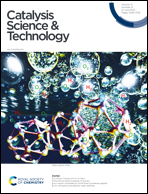MOF-derived Fe2O3/MoSe2 composites for promoted electrocatalytic nitrogen fixation†
Abstract
Due to the low activity and poor selectivity of current artificial nitrogen fixation catalysts, there is an urgent need to develop efficient and environmentally friendly electrochemical ammonia synthesis (EAS) electrocatalysts. Electrochemical ammonia synthesis is considered an environmentally friendly and sustainable method for artificial nitrogen fixation. Herein, Fe2O3 nanoparticles assembled on MoSe2 (Fe2O3/MoSe2) were first developed and regarded as an efficient electrocatalytic nitrogen fixation catalyst with high electroactivity. The Fe2O3/MoSe2 composites exhibited excellent NRR activity with an NH3 yield of 46.25 μg h−1 mg−1 at −0.5 V and an FE of 9.6% at −0.6 V vs. RHE. Notably, the Fe2O3/MoSe2 composites exhibited excellent stability and durability in recycling tests. According to the findings of density functional theory (DFT) calculations, it was discovered that the transmission of interfacial charges from Fe2O3 to MoSe2 can considerably intensify the electrochemical nitrogen reduction reaction (NRR) activity of Fe2O3/MoSe2 through facilitating the electrical conductivity of Fe2O3/MoSe2 and lowering the free energy obstacle for the rate-determining *N2 to *N2H formation step. This work provides a promising avenue for the green synthesis of NH3.



 Please wait while we load your content...
Please wait while we load your content...